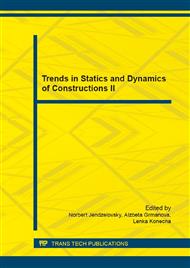[1]
PN-EN 1992-1-1: 2004/AC, Eurocode 2: Design of concrete structures. Part 1-1: General rules and rules for buildings, European Standard, (2010).
DOI: 10.3403/03178016
Google Scholar
[2]
CEB-FIB, Model Code for Concrete Structures 2010, FIB - International Federation for Structural Concrete, (2013).
DOI: 10.35789/fib.bull.0002
Google Scholar
[3]
CSA Standard A23. 3, Design of concrete structures, Canadian Standard Association, (2004).
Google Scholar
[4]
ACI Committee 318, Building code requirements for structural concrete and commentary, American Concrete Institute, United State America, (2011).
Google Scholar
[5]
M. Wieczorek, Influence of amount and arrangement of reinforcement on the mechanism of destruction of the corner part of a slab-column structure, Procedia Engineering 57 (2013) 1260–1268.
DOI: 10.1016/j.proeng.2013.04.159
Google Scholar
[6]
M. Wieczorek, Investigations concerning the corner part of the reinforced concrete structures in the emergency of removing the corner support, Procedia Engineering 65 (2013) 135–142.
DOI: 10.1016/j.proeng.2013.09.023
Google Scholar
[7]
F. Habibi, E. Redi, W.D. Cook, D. Mitchell, Assessment of CSA A23. 3 structural integrity requirements for two-way slabs, Canadian Journal of Civil Engineering 39 (2012).
DOI: 10.1139/l2012-013
Google Scholar
[8]
N.M. Hawkins, D. Mitchell, Progressive collapse of flat plate structures, Journal of the American Concrete Institute 76(7) (1979).
Google Scholar
[9]
D. Mitchell, W.D. Cook, Preventing Progressive Collapse of Slabs Structures, Journal of Structural Engineering 110(7) (1984).
Google Scholar
[10]
G.S.S.A. Melo, P.E. Regan, Post-punching resistance of connections between flat slabs and interior columns, Magazine of Concrete Research 50(4) (1998).
DOI: 10.1680/macr.1998.50.4.319
Google Scholar
[11]
Y. Mirzaei, Post-punching behavior of reinforced concrete slabs, School of Architecture, Civil and Environmental Engineering, EPFL, Switzerland, (2010).
Google Scholar
[12]
B. Wieczorek, Idea of a simplified model to determination of the load capacity of and inner slab-column connection after its punching, Procedia Engineering 65 (2013) 126–134.
DOI: 10.1016/j.proeng.2013.09.022
Google Scholar
[13]
B. Wieczorek, Numerical analysis of reinforcing bars in the support zone of central slab-column connections subjected to eccentric tension, Applied Mechanics and Materials 769 (2015) 245-251.
DOI: 10.4028/www.scientific.net/amm.769.245
Google Scholar
[14]
B. Wieczorek, Load-bearing capacity of reinforcing bars in the zone of the slab-column connection determined experimentally and in the result of numerical calculations, Procedia Engineering 65 (2013) 149–157.
DOI: 10.1016/j.proeng.2013.09.025
Google Scholar
[15]
B. Wieczorek, Load capacity of an internal slab-column connection depending on the geometric parameters of the reinforcement, Advanced Materials Research 969 (2014) 234-240.
DOI: 10.4028/www.scientific.net/amr.969.234
Google Scholar


